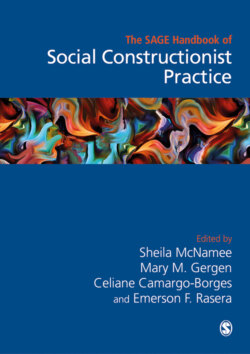Читать книгу The Sage Handbook of Social Constructionist Practice - Группа авторов - Страница 16
На сайте Литреса книга снята с продажи.
Inclusion and the Energizing of Innovation
ОглавлениеWhile the constructionist dialogues are broadly liberating in their implications, they do not give rise to a ‘new truth’ to which everyone must subscribe. Acknowledged are the multiple perspectives, values, and ways of life created by the peoples of the world, and the rich potentials of sharing. The advantages of this inclusion for the development of professional practices cannot be overstated. There is first a farewell to the ingurgitating conflict among various schools, disciplines, guilds, and the like for ontological primacy. The longstanding conflicts within the world of psychotherapy are illustrative. Early psychoanalytic claims to ‘truth about the mind’ gave way to a succession of battles among schools – Jungian, Rogerian, Behaviorist, systemic, cognitive, and bio-medical among them – for preeminent authority. Similar battles may be found in the fields of education, organizational management, counseling, and so on. Such battles have only been intensified by the demands for quantifiable evidence. From a constructionist perspective, however, schools of practice represent different forms of understanding, with different values, goals, and pragmatic potentials. The chief question then, is not which most accurately reflects the nature of the world, but when, where, how, and for whom might an orientation be useful. Here we replace a tradition of either/or with an invitation to curiosity. For example, are there enclaves for whom classic psychoanalysis is perfectly suited, while others might benefit from positive regard, and still others from a reinforcement regimen? And does this not open the possibility that indigenous healing or spiritual traditions might be ‘just right’ for certain people at certain times? We move, then, from the establishment of self-contained and defensive enclaves of practice, to thriving in an ecology of possibilities (Anderson, 1997; McNamee and Gergen, 1992).
It is just such a context that also invites the crossing of traditional boundaries among disciplines and professions. When one's concerns are primarily pragmatic, there is no single tradition of understanding or practice from which resources may be drawn. In opening a sea of possibilities so are the creative energies set in motion. In program evaluation, for example, one might think beyond traditional measurement practices, to include phenomenological reports, focus groups, and participant observation practices. Or, a practitioner concerned with conflict reduction, might build a new form of dialogue inspired by practices in organizational development, education, and collaborative action research. A therapist whose practice has traditionally relied on verbal exchange may find it inspiring to incorporate Buddhist meditational practices and role playing. In effect, with an open ear to the many voices of the world, a new wave of innovative practices is spawned.
